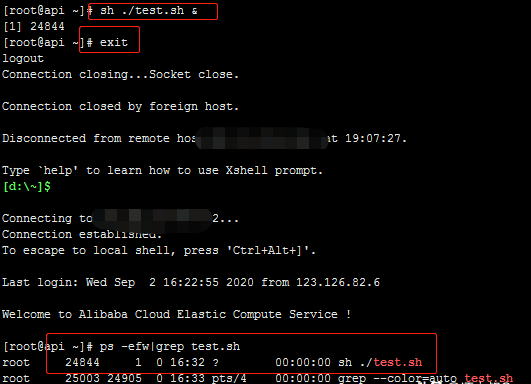Exploring the mysterious world of background operations in Linux
Let us explore a mysterious world in the Linux operating system - background running. In daily use, we often need to use background running to let tasks execute silently in the background without affecting our current work. So, how to implement background operation in Linux?
think
First of all, we need to consider a question. Why does the background program exit when you close the terminal directly? That is because when you close the terminal directly, the terminal will send a SIGHUP signal to the background task started in the current environment, causing the running program to hang. Then just ignore SIGHUP. La.
nohup
The most commonly used command is [nohup]. From the name, it can be seen that whether to suspend the running command, close the terminal or log out of an account, the process will continue to run. It must also be used with the [&] symbol.
Usage: nohup Command [ Arg … ] [ & ]

$ nohup sh test.sh & # 直接关闭当前终端,再打开一个查看 $ ps -few|grep test.sh
As can be seen from the above, the parent process of test.sh we are running has become [PID 1]., and is taken over by the Linux main process.
setsid
nohup means ignoring the SIGHUP signal. Are there any other ideas?
The setip command can reopen the session, inherit the ID of the parent process group, and escape the control of the parent process. As you can see from the picture below, the parent process of the test.sh script is already init 1. At this time, regardless of closing or exiting the terminal, it has nothing to do with the background program.
$ setsid sh test.sh

Another difference between setsid and nohup is that there is no need to use the & background symbol.
exit
Use the exit command to exit the terminal, but our program will continue to run. Why is this?
This is because when exiting the terminal using the exit command, the SIGHUP signal will not be sent to the task to which the terminal belongs. It is controlled by the huponexit configuration item. The default is off. You can use the shopt command to view it.

[root@api ~]# shopt |grep huponexit huponexit off
Configure huponexit to on, use the exit command again to exit, and the corresponding tasks will exit accordingly.
[root@api ~]# shopt -s huponexit [root@api ~]# shopt |grep huponexit huponexit on
trap
The trap command is a built-in command in Linux. The action to be taken when receiving the specified signal, followed by the name of the signal to be processed. Common signals are as follows:

When a script goes into the background and we don’t want the terminal to exit and close the program, we can add the trap command to the script to ignore the SIGHUP signal (hang the process).
#!/bin/sh trap "" HUP while true;do date >> /root/test.txt sleep 1 done
Linux screen command is used for multiple window management programs. It can create a terminal and let the program run in it

screen sh test.sh &
As can be seen from the example, the parent process of the test script is the screen terminal process, and the parent process of the screen terminal, PID1, has also completed the running of the background process.
In short, running in the background is a very common and practical technique in Linux. Whether it is performing some background services on the server side or completing some long-running tasks on a personal computer, background operations can help us improve efficiency and facilitate our daily work.
The above is the detailed content of Exploring the mysterious world of background operations in Linux. For more information, please follow other related articles on the PHP Chinese website!

Hot AI Tools

Undresser.AI Undress
AI-powered app for creating realistic nude photos

AI Clothes Remover
Online AI tool for removing clothes from photos.

Undress AI Tool
Undress images for free

Clothoff.io
AI clothes remover

AI Hentai Generator
Generate AI Hentai for free.

Hot Article

Hot Tools

Notepad++7.3.1
Easy-to-use and free code editor

SublimeText3 Chinese version
Chinese version, very easy to use

Zend Studio 13.0.1
Powerful PHP integrated development environment

Dreamweaver CS6
Visual web development tools

SublimeText3 Mac version
God-level code editing software (SublimeText3)

Hot Topics
 1377
1377
 52
52
 Unable to log in to mysql as root
Apr 08, 2025 pm 04:54 PM
Unable to log in to mysql as root
Apr 08, 2025 pm 04:54 PM
The main reasons why you cannot log in to MySQL as root are permission problems, configuration file errors, password inconsistent, socket file problems, or firewall interception. The solution includes: check whether the bind-address parameter in the configuration file is configured correctly. Check whether the root user permissions have been modified or deleted and reset. Verify that the password is accurate, including case and special characters. Check socket file permission settings and paths. Check that the firewall blocks connections to the MySQL server.
 Solutions to the errors reported by MySQL on a specific system version
Apr 08, 2025 am 11:54 AM
Solutions to the errors reported by MySQL on a specific system version
Apr 08, 2025 am 11:54 AM
The solution to MySQL installation error is: 1. Carefully check the system environment to ensure that the MySQL dependency library requirements are met. Different operating systems and version requirements are different; 2. Carefully read the error message and take corresponding measures according to prompts (such as missing library files or insufficient permissions), such as installing dependencies or using sudo commands; 3. If necessary, try to install the source code and carefully check the compilation log, but this requires a certain amount of Linux knowledge and experience. The key to ultimately solving the problem is to carefully check the system environment and error information, and refer to the official documents.
 How to solve mysql cannot be started
Apr 08, 2025 pm 02:21 PM
How to solve mysql cannot be started
Apr 08, 2025 pm 02:21 PM
There are many reasons why MySQL startup fails, and it can be diagnosed by checking the error log. Common causes include port conflicts (check port occupancy and modify configuration), permission issues (check service running user permissions), configuration file errors (check parameter settings), data directory corruption (restore data or rebuild table space), InnoDB table space issues (check ibdata1 files), plug-in loading failure (check error log). When solving problems, you should analyze them based on the error log, find the root cause of the problem, and develop the habit of backing up data regularly to prevent and solve problems.
 Can mysql run on android
Apr 08, 2025 pm 05:03 PM
Can mysql run on android
Apr 08, 2025 pm 05:03 PM
MySQL cannot run directly on Android, but it can be implemented indirectly by using the following methods: using the lightweight database SQLite, which is built on the Android system, does not require a separate server, and has a small resource usage, which is very suitable for mobile device applications. Remotely connect to the MySQL server and connect to the MySQL database on the remote server through the network for data reading and writing, but there are disadvantages such as strong network dependencies, security issues and server costs.
 Unable to access mysql from terminal
Apr 08, 2025 pm 04:57 PM
Unable to access mysql from terminal
Apr 08, 2025 pm 04:57 PM
Unable to access MySQL from the terminal may be due to: MySQL service not running; connection command error; insufficient permissions; firewall blocks connection; MySQL configuration file error.
 What is the most use of Linux?
Apr 09, 2025 am 12:02 AM
What is the most use of Linux?
Apr 09, 2025 am 12:02 AM
Linux is widely used in servers, embedded systems and desktop environments. 1) In the server field, Linux has become an ideal choice for hosting websites, databases and applications due to its stability and security. 2) In embedded systems, Linux is popular for its high customization and efficiency. 3) In the desktop environment, Linux provides a variety of desktop environments to meet the needs of different users.
 Monitor MySQL and MariaDB Droplets with Prometheus MySQL Exporter
Apr 08, 2025 pm 02:42 PM
Monitor MySQL and MariaDB Droplets with Prometheus MySQL Exporter
Apr 08, 2025 pm 02:42 PM
Effective monitoring of MySQL and MariaDB databases is critical to maintaining optimal performance, identifying potential bottlenecks, and ensuring overall system reliability. Prometheus MySQL Exporter is a powerful tool that provides detailed insights into database metrics that are critical for proactive management and troubleshooting.
 How to solve the problem of missing dependencies when installing MySQL
Apr 08, 2025 pm 12:00 PM
How to solve the problem of missing dependencies when installing MySQL
Apr 08, 2025 pm 12:00 PM
MySQL installation failure is usually caused by the lack of dependencies. Solution: 1. Use system package manager (such as Linux apt, yum or dnf, Windows VisualC Redistributable) to install the missing dependency libraries, such as sudoaptinstalllibmysqlclient-dev; 2. Carefully check the error information and solve complex dependencies one by one; 3. Ensure that the package manager source is configured correctly and can access the network; 4. For Windows, download and install the necessary runtime libraries. Developing the habit of reading official documents and making good use of search engines can effectively solve problems.




